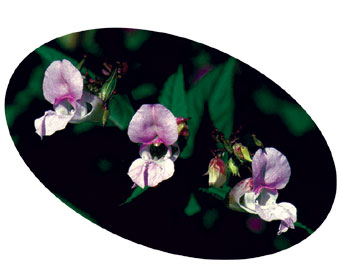|
Flower Essence Spotlight
Reading from the Book of Nature: Insights from Julian Barnard
Editor's Note: Julian Barnard's book, Bach Flower Remedies: Form & Function , features thoughtful discussion about the botanical gestures of the Bach remedy plants. Barnard's description of Impatiens helps us to understand its clinical healing qualities. Impatiens (not the garden variety) was the first flower remedy made by Dr. Bach and, Barnard indicates, was Bach's own "type remedy." Impatiens glandulifera — Impatiens (Himalayan Balsam, introduced into Britain in 1839) is an annual, which grows from seed each year. By July it can be more than two metres tall, given favourable conditions. It likes the loose, damp soil by water and thrives on any kind of fertilizer. The seeds are heavy and remain lodged in the banks of silt after winter floods. Once germinated, they cover the bare soil with a vigorous growth. So a colony of plants develops, choking back any competitor with superior growth and numbers. Compared to most annuals its growth is rapid, maybe twenty-five millimetres a day, so that speed is a quality to note. The structure of the plant is simple. The stem, like a bamboo, is constructed in segments with structural rings to strengthen it. It is fleshy and hollow, the whole plant being heavy with water. If the stem is cut or damaged the plant quickly droops and collapses. The stems are tinged with red, a copper-bronze, denoting the presence of metals. The leaves are dark green, strong in chlorophyll. The side stems rise at an angle of sixty degrees to the main stalk, which is round, like the shaft of a spear. The leaves are elegant, large and lanceolate (spear shaped) with a broad midrib. The pattern of growth is erect, cardinal, directed, strongly structured. On the main stem we can see the energy lines drawn on the surface like the straight, stretched muscles which hold the stem erect. Already we have information about the plant which is describing it in a language that corresponds to the human state. To pick out a few of the key words: speed, strength, spear-shaft, structure, tension. An image is beginning to appear. What is being suggested here is that the language used in description gives information about the gesture of the plant. More than that, the picture of the plant is equivalent to the picture of the human emotional state. We have the gesture of the person: the gesture of the plant.... Now, a strange thing happens with the Impatiens plant. When the pods are ripe the seeds are shot away from the plant with an explosive force, like bullets from a gun. You can experience this if you touch the pods or if any movement nearby triggers them. The sides of the pod break open drawing back like a coiled spring, and all with such force (action and reaction being equal and opposite) that the seeds can be fired several yards. You hear them splattering like lead shot on the leaves nearby. This explosive tension is very illustrative of the Impatiens type. Remember Bullen's comment on Bach — ‘quick to anger, but quickly over'? This is the sparky irritability of the Impatiens which shows itself in unexpected outbursts of energy.... Bach was specific, right from the start, only the pale mauve flowers should be selected for their therapeutic quality, not the red, although the red outnumber the mauve by ten to one. Consider this from the point of view of colour alone and it seems most probably that the red flowers are heating, the mauve cooling.... The impact of the remedy plant upon consciousness...extends to all five senses and beyond. Touching the plant leads to the discovery of the exploding seeds, but the flowers, leaves and stems can also be felt and more information obtained. The smoothness of the "skin" is most striking — being filled with water, the stems are cool to touch. Yet for all the boldness of growth, the plants are rather delicate and crush easily.... To be with the plant is to sense the gentle easing of the mind, the peace of forgiveness, restfulness, the release of mental tensions and desperation, the admitting of spiritual light and truth — all phrases which describe what Bach felt about the remedy in its positive state. The positive aspect, often forgotten in the mass of negative indications, is what the plant shows of itself. This is the plant's consciousness, perceived with our sixth sense. Reference: Barnard, Julian, Bach Flower Remedies: Form & Function (Great Britain: Flower Remedy Programme, 2002), pp 33-44. Read a case study by Gayle Eversole about an elderly woman who used Impatiens for pain relief from a severe spider bite. Read an article by practitioner Mimi Ellison describing the use of Impatiens for pain relief in cases involving osteoporosis with fractured vertebrae, sinus surgery, and pain management for animals. |

To install this Web App in your iPhone/iPad press ![]() and then Add to Home Screen.
and then Add to Home Screen.


